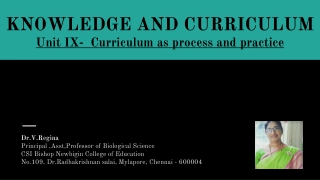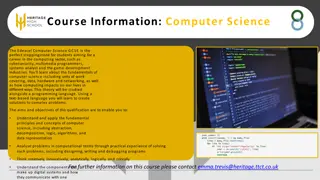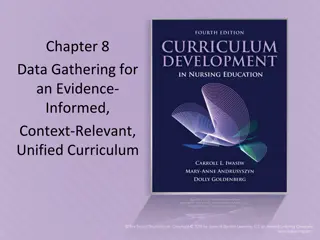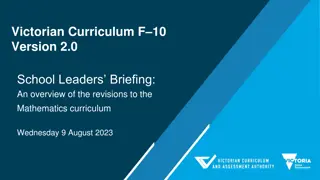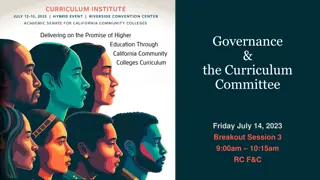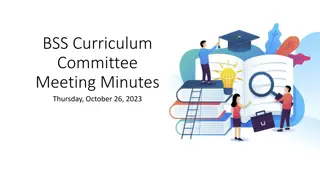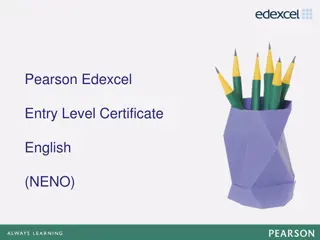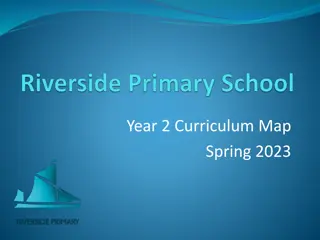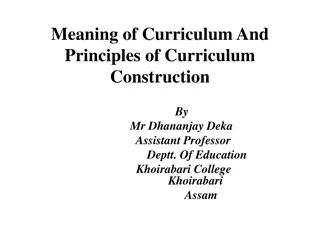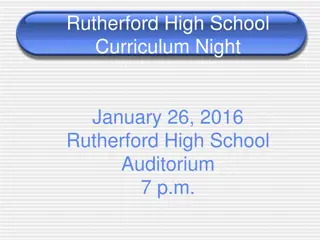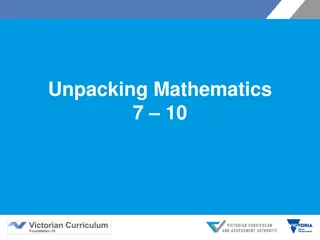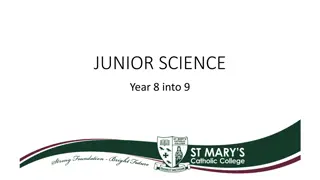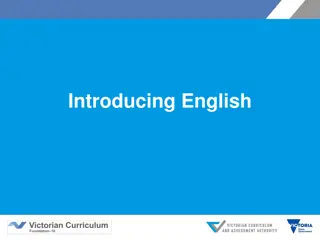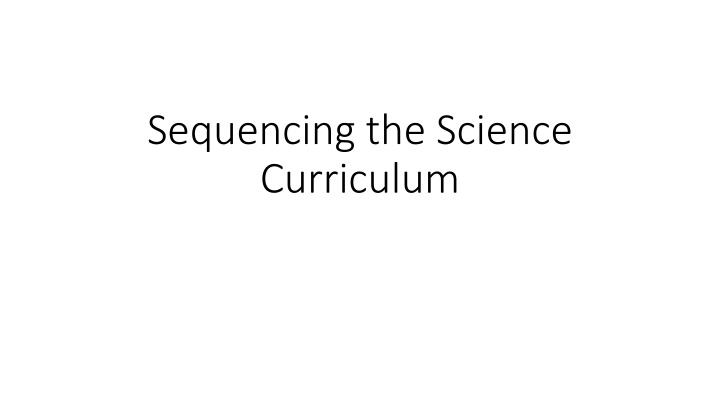
Sequencing the Science Curriculum: Biology and Chemistry Concepts
Explore the sequencing of the science curriculum, covering major ideas in biology such as the cellular basis of life, heredity, adaptation, and health, as well as key concepts in chemistry like chemical reactions and properties of substances. Delve into educational resources and frameworks that inform science teaching practices and curriculum design.
Download Presentation

Please find below an Image/Link to download the presentation.
The content on the website is provided AS IS for your information and personal use only. It may not be sold, licensed, or shared on other websites without obtaining consent from the author. If you encounter any issues during the download, it is possible that the publisher has removed the file from their server.
You are allowed to download the files provided on this website for personal or commercial use, subject to the condition that they are used lawfully. All files are the property of their respective owners.
The content on the website is provided AS IS for your information and personal use only. It may not be sold, licensed, or shared on other websites without obtaining consent from the author.
E N D
Presentation Transcript
Sequencing the Science Curriculum
Where does our sequencing come from? Where does our sequencing come from? Big ideas in science (ASE) Best Evidence Science Teaching (BEST) reports and resources (recommended by EEF) National curriculum GCSE specifications Ofsted Science review document
Biology B1 The cellular basis of life Organisms are made of one or more cells. Multicellular organisms have a hierarchal organization of cells, tissues, organs and organ systems that work together to keep cells alive. Cells need a supply of energy and molecules to carry out life processes. B2 Heredity and life cycles Each generation of organisms inherits characteristics from the one before, which arise from genetic information stored in the DNA of the genome and are affected by the environment. Organisms grow and develop as they get older; they pass genetic information to their offspring when they reproduce, and the life cycle begins again. B3 Organisms and their environment All organisms, including humans, depend on, interact with and affect the environments in which they live and other organisms that live there. B4 Variation, adaptation and evolution There is a great diversity of organisms, living and extinct, with many similarities and differences between them. These differences cause species to evolve by natural selection of individuals better adapted to compete for limited resources when environmental conditions change and the passing of advantageous heritable characteristics to subsequent generations. B5 Health and disease Organisms must stay in good health to survive and thrive; the health of an individual organism results from interactions between the organism s body, behaviour, environment and other organisms. Big Idea B1.1: Cells (Students learn about the 7 life processes, cell structure and function of organelles) B2.1 Inheritance and the genome (students learn about the structure and function of the genome) B3.1 Interdependence of organisms (Students learn about food chains and webs) B4.1 Variation (students learn about the differences within species and the fossil evidence for changes in species over time) B5.1 Health and disease (Students learn about good and ill health and disease) 7 B1.2 Cells to organ systems (Students learn about cells working together to form tissues, organs and systems) B2.2 Changes within an organism s lifetime (students learn about growth through mitosis and life cycles) B3.2 Ecosystems (Students learn about ecosystem components and dynamics) B4.2 Classification (Students learn how and why we identify and classify organisms) B5.2 Human lifestyles and health (Students learn about the importance of health diet and exercise to health) 8 B1.3 Biochemistry (Students learn about processes within cells such as photosynthesis and respiration) B2.3 Reproduction (Students learn about sexual reproduction, asexual reproduction and contraception) B3.3 Biodiversity and human impacts (Students learn about biodiversity, conservation and sustainability) B4.3 Evolution (Students learn about the process of natural selection and how this explains the evolution of species) B5.3 Infectious disease (Students learn about the transmission of pathogens and preventing infection) 9 CB1 Key concepts in Biology CB2 Cells and Control CB3 Genetics CB4 Natural Selection and genetic modification CB5 Health, disease and the development of medicines 10 CB6 Plant structure and their functions CB8 Exchange and transport in animals CB9 Ecosystems and material cycles CB7 Animal coordination, control and homeostasis 11
Chemistry C3 Chemical reactions During chemical reactions atoms are rearranged and new substances are formed C1 Substances and properties Materials are either made of a single chemical substance or a mixture of substances which have distinctive properties. C2 Particles and structure All matter is made up of atoms. The collective, structural arrangement and behaviour of the atoms explains the properties of different substances. C4 Earth chemistry Substances can move between Earth s atmosphere, hydrosphere, geosphere and biosphere as part of large-scale systems C5 Dynamic Earth Big Idea The rocks and landscape around us appear unchanging and permanent, but careful observation can detect the effects of weathering and erosion on exposed rocks, and the laying down of sediments that in the right conditions can be changed into new rock. Longer term processes transform rocks deep underground and bring fresh rock to the surface. Understanding the dynamic Earth helps us to identify and utilize resources it contains and find ways to build a sustainable and environmentally stable future. C1.1 Solutions (Students learn about substances, solutions and separating solutions) C1.2 Solubility (Students compare solubility) C2.1Substances and mixtures (Students learn about the particle model of matter, states of matter and particles in solutions) C2.2 Atomic structure (Students learn about the atomic model) C2.3 Elements and compounds (Students learn about atoms, molecules, symbols and formulae) C3.1Chemical change (Students learn about formation of new substances) C3.2Chemical reactions (Students learn about reactions in solution and combustion) C4.1 Air pollution and the water cycle (Students learn about air quality and water cycle processes) C5.1Earth s resources (Students learn what is in a rick, inside the Earth and how rocks can be made by heating) 7 C3.4 Periodic table (Students learn about the patterns in the periodic table) C2.4 Evaporation (Students learn to explain what happens during evaporation) C2.5 Chemical change (Students learn about the rearrangement of atoms) C3.3 Acids and alkalis (Students learn about neutralization and the pH scale) C4.2Chemical weathering (Students learn about chemical weathering through acid rain) C5.2 Weathering and erosion (Students learn about physical weathering and erosion) 8 C2.6 Understanding chemical reactions (Students learn to represent chemical reactions and the conservation of mass) C3.5Energy and reactions (Students learn about exothermic and endothermic reactions) C5.3Rock changes (Students learn about making rocks by pressure and cementing as well as making fossil fuels) 9 CC2 Separating mixtures CC4 The periodic table CC5-7 Bonding and types of substance CC1 States of matter CC3 Atomic structure CC8 Acids and Alkalis CC9 Calculations involving masses CC10-12 Obtaining and using metals 10 CC13 Groups in the periodic table CC14 Rates of reaction CC15 Heat energy changes in chemical reactions CC17 Earth and atmospheric science CC16 Fuels 11
Physics P3 Sound, light and waves Waves are key to explaining how energy can be transferred from one object to another by radiation, even when the objects are not touching, Waves carry information that can be detected by humans or manufactured detectors. Understanding waves helps us to communicate, explore the universe and transfer energy to where we want it. P4 Electricity and magnetism Matter is held together by electrostatic forces, and these influence chemical changes. Electricity and magnetism initially seem to be distinct phenomena, but are later found to be closely interrelated. Understanding electricity and magnetism helps us to develop our technology and find application that can transform our everyday lives. P5 Earth in space Earth is the only planet known to have abundant and complex life. Understanding how the Earth and space systems interact, how they affect us and how we affect them is vital for our survival. Exploring our origins and our place in the universe feeds the intrinsic curiosity of humans and develops a sense of wonder. Big Idea P1 Forces and motion Force is the key to explaining changes in the motion of an object or in its shape. The motion of an object can be explained or predicted if you know the sizes and directions of all the forces that act on it. Understanding forces helps us to predict and control the physical world around us. P2 Matter The world is made of matter. Anything that can be stored in a container, or weighed, is matter. Scientific ideas can help to explain why a given material behaves as it does, and may help scientists develop new materials with specific properties. P1.1 Forces (Students learn about what forces do, balanced and unbalanced forces, friction and transfers of energy) P2.1 Heating and Cooling (Students learn about temperature, thermal conduction and thermal store of energy) P3.1 Sound and light (Students learn about the production and transmission of sound and the characteristics of light) P4.1 Circuits (Students learn about making simple series circuits and the basics of current, voltage and static electricity) P5.1 Solar system and beyond (Students learn about the planets, solar system, gravity, the night sky, stars and galaxies) 7 P1.2 Moving by force (Students learn about changing motion, describing speed and the effects of drag) P2.2 Floating and sinking (Students learn about density, pressure in fluids and convection) P3.2 How we see (Students learn about the passive eye model of vision and seeing in colour) P4.2 Further circuits (Students learn about resistance and parallel circuits) P5.2 Earth and sun (Students learn about days, seasons and time) 8 P1.3 Further forces (Students learn about mass and weight, hidden forces and turning effects) P3.3 Making images (Students learn about the ray model of light to explain images, refraction and lenses) P3.4 Waves (Students learn about waves on eater and ropes and the wave model of sound) P4.3 Magnets and electromagnets (Students learn about magnetic fields and how electromagnets work) 9 CP1-2 Motion and forces CP6 Radioactivity CP3 Conservation of energy CP4 Waves CP5 light and the electromagnetic spectrum 10 CP7-8 Forces doing work and their effects CP12 Particle Model CP13 Forces and matter CP9 Electricity and circuits CP10 Magnetism and the motor effect CP11 Electromagnetic induction 11
Disciplinary knowledge Disciplinary knowledge practical science practical science Year 7 working scientifically Definitions for variables, risks, safety and how science works as a community Year 8 Data handling Year 9 Applying variables, selecting equipment and methods. Year 10 Evaluating and concluding, errors and anomalies Year 11 improvements to practicals
Disciplinary knowledge Disciplinary knowledge Where does our scientific knowledge come from and hinterland scientific knowledge come from and hinterland Where does our Year 7 Project work, Hook and the cell Year 8 Biography literacy tasks e.g. Isaac Newton, ISS Year 9 The role of Rosalind Franklin in the discovery of DNA, the role of Henrietta Lacks in developing screening for cervical cancer, the role of Lewis Latimer in the invention of the light bulb (medical science club) Year 10 Ethics and morality in relation to genetics, Mendeleev and the periodic table Year 11 The inventions of Nikola Tesla, the importance of biodiversity
B1 Cells B1 Cells Year 7 Cells Learning outcomes Life Processes Students are able to recall the names of the 7 life processes Students are able to recall definitions for the 7 life processes Using Microscopes Students are able to describe how to prepare a simple slide for use with a light microscope Students are able to identify parts of a light microscope Students are able to describe the advantages and disadvantages associated with using light microscopes Animal cells Students are able to identify a simple animal cell diagram Students are able to label a diagram of an animal cell Students are able to name the organelles found in animal cells Students are able to give a simple description of each organelles function Plant cells Students are able to identify a simple plant cell diagram Students are able to label a diagram of a plant cell Students are able to name the organelles found in plant cells Students are able to give a simple description of each organelles function Students are able to identify organelles found in plant cells but not in animal cells Bacteria Students are able to identify a simple bacterial diagram Students are able to label a diagram of a bacteria Students are able to name the organelles found in bacteria Students are able to give a description of each organelles function Students are able to identify how bacteria are different from animal and plant cells Other cells Students are able to compare euglena and yeast to animal, plant and bacterial cells Students are able to name examples of specialised cells Students are able to give a simple description of how a red blood cell, sperm cell, root hair cell, ciliated epithelial cell and a palisade cell are all specialised Specialised cells
B1 Cells B1 Cells Year 8 Organ Systems Learning outcomes Organisation Students are able to describe the levels of organisation in multicellular organisms Students are able to describe how specialised cells form tissues and organs and work as part of complex organ systems. Movement in cells and tissues Students are able to describe the process of diffusion Students are able to give examples of diffusion in cells Students are able to describe the process of osmosis Students are able to give examples of osmosis in cells Enzymes Students are able to recall a simple definition for enzymes Students are able to name enzymes involved in digestion The digestive system Students are able to recall the organs that form the digestive system Students are able to label a diagram showing the organs that form the digestive system Students are able to describe the role of the organs that form the digestive system Students are able to describe the journey of food through the digestive system The cardiovascular system Students are able to recall the organs that form the cardiovascular system Students are able to label a diagram showing organs the organs that form the cardiovascular system Students are able to describe the role of the organs that form the cardiovascular system Students are able to describe the journey of blood through the cardiovascular system Plant organ systems Students are able to recall the three basic organs of plants; roots, stems and leaves Students are able to give a simple description of how the roots, stems and leaves are adapted for their function
B1 Cells B1 Cells Year 9 Biochemistry Learning outcomes Students are able to recall the essential nutrients needed by plants Students are able to describe how the plant obtains these Plant nutrition Students are able to recall the word equation for photosynthesis Students are able to identify the reactants and products of the photosynthesis reaction Students are able to explain the different ways plants use glucose Photosynthesis Students are able to describe the role of enzymes in photosynthesis Enzymes Students are able to recall the word equation for respiration in animal cells Students are able to link the products of photosynthesis in plants with the reactants of respiration Aerobic respiration Students are able to recall the word equation for anaerobic respiration in muscle cells Students are able to compare and contrast aerobic and anaerobic respiration in humans Students are able to recall the word equation for anaerobic respiration in yeast Students are able to describe some uses of anaerobic respiration in yeast Anaerobic respiration Students are able to describe the process of active transport Students are able to give examples of active transport in animal and plant cells Students are able to compare active transport with diffusion and osmosis Active transport
B1 Cells B1 Cells Year 10 CB1 Key Concepts in Biology Learning outcomes
B1 Cells B1 Cells Year 10 CB2 Cells and Control Learning outcomes
B1 Cells B1 Cells Year 11 CB6 plant Structure and Function Learning outcomes
B1 Cells B1 Cells Year 11CB8 Exchange and Transport in Animals Learning outcomes

